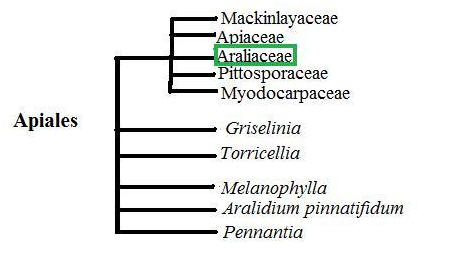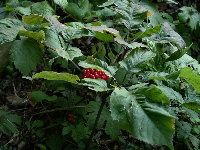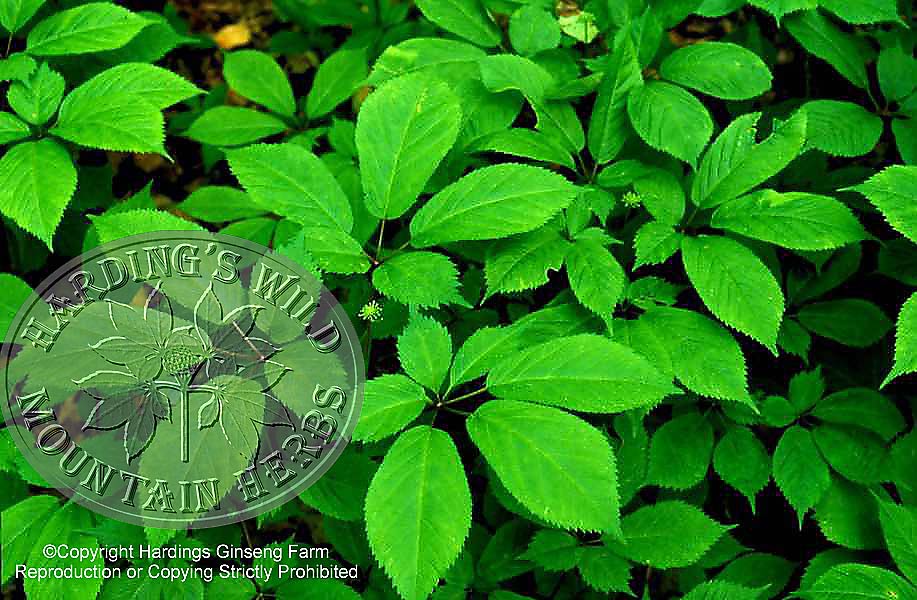Classification
Domain- Eukarya
The cells have nuclei and membrane bound
organelles (2).
Kingdom- Plantae
The cells contain cellulose cell walls,
chloroplasts, and are rectangular in shape (2).
Phylum- Eudicots
The plant has non-parallel venation in leaves
and has two cotyledons. The flower petals are in
groups of fours, fives, and groups of fours or
fives. The seeds of the plant are contained in
fruits which are part of the plants ovaries
located inside the plant. The
turnip is located in the Eudicot phylum as
well (2).
Class- Asterids
The plant has sympetaly, 5 or fewer stamens, stamens alternate with petals, Iridoid compounds, and a single layer of integuments in ovule (2).
Order- Apiales
The flowers are arranged in umbrules. An umbel is the arrangement of flowers in which each flower stalk grows from the same point at the top of the stem. In the end the plant looks like an umbrella (17). This order also contains the carrot family (15).
Family- Araliaceae
This is known as the Ginseng family. This family consists mostly of woody species with hermaphrodite flowers in a simple umbel. The leaf lobes are hand-shaped and the flowers relatively inconspicuous with two pistils, an inferior gynaecium, a small calyx, and a white to greenish corolla with free petals and sepals (10).
Genus- Panax
At the age of four ginseng produces flowers in
the spring and produces seeds in
berries in the fall (19).
Species-
Panax ginseng
Panax quiquefolius
Panax waangianus
Panax pseudoginseng
Panax triflius
The different species of Ginseng are located in different places making them separate species. For example: Panax ginseng is located in China, Panax japonicas is located in Japan, and Panax quiquefolius is located in the United States of America.
I
will mostly focus on Panax
ginseng and Panax
quiquefolius. These are the most commonly grown and used of
ginseng.
Panax
ginseng
means panacea or “cure all” in latin. In the Chinese terminology
the common name Ginseng means “man root” or “man essence” (9).
Other common names for Panax
quiquefolius are: American ginseng, sang, redberry, and
fivefingers. Panax ginseng
has the common name Chinese Ginseng due to its origin (14).

This phylogenetic tree is based on DNA sequences (DNA of each kingdom is compared to each other). It shows Ginseng is part of the Eukaryotes which are closely related the Archaea. It was originally thought the Archaea were closely related to the Bacteria but molecular testing has shown otherwise (15).

This phylogenetic tree is based on small subunit rRNA. The molecular data confirmed an older system based on morphologies. Each group represented is a monophyletic group that can be traced back to the common ancestor the Eukaryotes. Evolutionary data is not represented since researchers are still deciding which group would have been the most ancient lineage. This tree shows that Ginseng is a member of the Angiosperms which are closely related to the Gnetales. Within the Angiosperms is the order the Apiales which contains the Ginseng family (15).

Within the Eukaryotes is a order called the Apiales.
This tree is based on a small unit of rRNA (15).
The ribosomal RNA of Ginseng was compared to those of all the other
families and was considered part of the Araliaceae. This family
consists mostly of woody species with hermaphrodite flowers in a
simple umbel. The leaf lobes are hand-shaped and the flowers
relatively inconspicuous with two pistils, an inferior gynaecium, a
small calyx and generally a white to greenish corolla, with free
petals and sepals (10).

Within the Apiales is the Ginseng species. These are all the Ginseng species in relation to each other based off sequences of the chloroplast trnC-trnD region and the internal transcribed spacer (ITS) regions of nuclear ribosomal DNA. This phylogenetic chart shows that Panax trifolius is the least similar and perhaps the most primitive of all of the Ginseng species. Panax ginseng’s closest relative is Panax quinquefolius. Though they are related very closely to each other they are still very different in what qualities they possess (5)(6).


